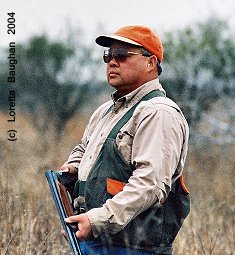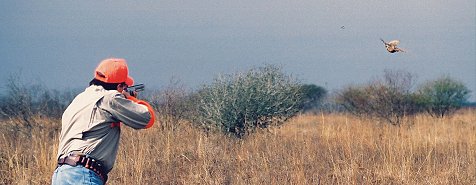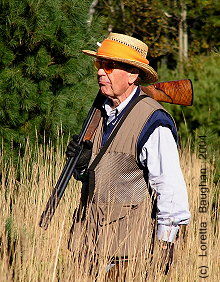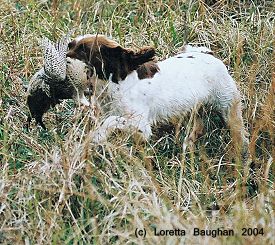  During recent years the AKC and the spaniel parent club, the English Springer Spaniel Field Trial Association, have become extremely concerned about setting standards for safe gunning at field trials. Anyone who wishes to gun a field trial must now go to a seminar and each new gun is carefully worked into shooting situations at field trials before they become full time members of a shooting team. The same attention has also been given to spaniel hunting tests. A booklet is being produced to assist new club members in understanding
all of the nuances of successful gunning and hopefully becoming productive club members during spaniel training sessions. This booklet should be read in conjunction with two other publications: The Art of Field Trial Gunning by Gail W. Luther, Jr. and Gunnerís Guidelines for Spaniel Hunting Test by C.S. Urland, Jr.
"The gun must never shoot, if, in his judgment, it is unsafe for any reason. A dead bird is not worth risking injury to a dog, a person or damage to property."
It is hoped that these guidelines will provide the gunner with a proper code of conduct to insure both effectiveness and safety at a typical spaniel training session. It is this authorís opinion that training sessions are the single most dangerous situation in the spaniel game. Many times club members are doing other things in the field at the same time as a dog is being run. For instance, a member with a new puppy may be throwing training dummies on one side of the field while other members are planting and shooting birds over their spaniels on the other side of the field. There is usually more chaos in the parking area at a training session and more distractions for a gun.
An additional element is created by the use of pigeons. Since game birds are not always available, most clubs rely on pigeons for training sessions. Pigeons do not fly straight like game birds. Instead, they will rise into the air, swoop, turn and sometimes loop back behind the guns. This creates a potentially very dangerous situation.
Anyone who attends a spaniel training session must wear blaze orange. Spectators must always be aware of what is going on in the field so that they can cooperate with the guns and not create unusually dangerous situations by wandering around or getting in the potential line of fire. The guns must also be aware, at all times, of the location of the parking area and the gallery.
The following are the basic ten commandments of shooting safety and they cannot be repeated often enough:
Proficiency and Equipment
A new member should not expect to gun at a spaniel training session unless invited to do so by a member. It is important that a new member attend several training sessions to get a feeling for what the handlers are doing and the gunning situations that can arise. It cannot be emphasized more that gunning at a training session must be efficient and accurate. Most of the handlers want a bird shot between 35 and 50 yards from the dog. It is important that anyone who guns at a training session be an excellent shot. Most hunters believe that they are good shots and yet can rarely score better than 30 or 35 on a sporting clay course. That is not good shooting. A good shot
should be able to achieve a consistent score on a sporting clay course in the 70ís. I realize this is an artificial standard but at the moment it is the only standard we have available. Proficiency at skeet and trap are also good indicators of a shooterís level of competence.
It is preferred that anyone gunning at a spaniel training session use a 12 gauge gun with modified and full chokes. This will guarantee that the bird will be killed cleanly at distances between 35 and 60 yards. A training session is not the appropriate place to try out the new .20 gauge or .410 gauge that you recently purchased. It may result in wounded birds that may either be lost or present a much more difficult situation for a handler with a young dog than was anticipated.
It has been our experience that only high brass shells (3-1/4 dram equivalent powder/ 1-1/8 of 1-1/4 ounce shot) with 5 or 6 shot should be used in training sessions. Even pigeons are difficult to knock down efficiently with 7-1/2 or 8 shot.
Gunner's Responsibilities
Gunning at a spaniel training session is not a task to be taken lightly. Every handler has a dog in a different phase of his training. Some may be working with young dogs who are either being steadied or introduced to birds for the first time. Others may have veteran dogs and they are trying to work on a quartering problem, a steadying problem, an honoring problem, etc... It is extremely important that the guns always know what the handler intends to do before they go into the field. Always ask the handler what he is working on and whether there are any special instructions. The guns should also know what birds are being used. For instance, pheasants may run and move
around more than chukars. As previously stated, pigeons present an additional problem because of their tendency to swoop, dive and change direction without notice.
The Basics
Always know what a handler is working on.
All birds must be shot within 35-50 yards. The guns must be consistent. A dog learns nothing from a 10 or 20-yard retrieve. It is essential that a gun use both barrels. If you miss the first shot take a second shot.
Brace Work
Brace work can also cause a great deal of confusion for an inexperienced gun. When two dogs are working side by side, each gun must not only be aware of the position of his handler and the dog, but must also be aware, generally, of the position of the other dog. Never shoot a bird that is flushed from the other side of the course directly over the head of the dog on your side of the course. This can be dangerous and create a difficult situation for the handler. Always allow a crossing bird to clear the dog before a shot is taken.
The center gun must be the most experienced gun of the team. He must keep an eye on both dogs and be aware of situations as they develop. An inexperienced gun should not take the center position in a brace until he has had a sufficient number of training sessions to understand the situation thoroughly.
If a bird flushes to the left or the right of the handler, the gun on that side must take the first shot. It is not appropriate for the gun on the right side to "poach" a bird on the left side of the course. If a bird flushes and heads toward the left side, the left gun must take the bird. If a bird flushes straight away, both guns should cooperate to kill the bird.
The gun must always mark the birdís fall. Learn to sight the bird on some distant landmark, such as a tree or bush. Do not take your eye off the fall until the dog has reached the fall area. Remember, the handler is watching the dog and is not necessarily watching the fall. If the dog does not mark it correctly, the handler will need the gunsí assistance to direct the dog.
The gun must also be aware that many times the handler does not know if the bird has been hit. If there is no one walking behind the handler, then the gun should indicate, after a shot, whether to send the dog or not. For this reason, the gun must be experienced at handling spaniels. Many times a wounded bird can create too many problems for the dog and it should not be sent. This is a judgment call at all times. For instance, if a bird is lightly wounded and goes down at 70 or 80 yards, it may not be a good idea to send the dog in a training session. The gun should also be aware of whether it is an extremely hot day and whether or not the dog had any kind of a mark on the bird. These calls take time and experience. It is very frustrating for a handler to be told to send his dog on a long retrieve and to then find out that the bird was only lightly wounded and ran off and the dog fails the retrieve. This causes more harm than good. If a bird is obviously dead, then sending the dog is not nearly as risky. The guns must be alert to all situations that may arise in regard to the handling of a spaniel.
If a dog is on a retrieve, do not shoot a bird that volunteers. This will accomplish nothing but to confuse the dog. It is better to let the bird fly away.
When a handler is training a young dog, he may wish to have the dog flush pigeons and have the guns shoot the pigeons over the dog even though the dog is not steady. This is a very difficult and potential dangerous situation. Under no circumstances should an inexperienced gun be asked to participate in this drill. The gun should only shoot at the bird when the bird has achieved sufficient height above the dog and distance from the dog, that the dog is no longer in the sight picture. If the dog is running close behind the bird, do not shoot. It is not worth risking injury to the dog.
The gun must never shoot, if, in his judgment, it is unsafe for any reason. A dead bird is not worth risking injury to a dog, a person or damage to property.
In his hunt test guidelines, Chuck Urland discusses "zones of fire". The following elements establish a "zone of fire" for a particular gunner:
The illustrations contained in Chuckís Hunting Test Guidelines are excellent and should be studied by all gunners. They are equally applicable to training sessions.
Rolling in Birds
This is another situation that creates a problem for inexperienced guns. Many times, the conditions, the lack of cover or the age and experience of the dog, will make it necessary for the gun to roll a bird in. If you do not know how to do this, please get instructions before going into the field. Each bird type requires a different procedure.
Conclusion
Training sessions are great fun for all of the participants. One of the reasons we love dog training is it keeps us in the field, doing what we love to do, twelve months of the year. However, as stated, they can be potentially dangerous and require everyoneís continued vigilance about safety. It is hoped that this article will provide some sensible guidelines for training sessions and help a new club member to feel more comfortable with what is going on at a typical training session. New members are encouraged to ask a lot of questions. The only way you will learn what each handler is doing and why they are doing it, is to inquire.
Training sessions represent 90% of a dog ownerís life and experience. Most determined field trialers get to participate in 8 or 9 field trials a year. This is usually a one-day event and he may only have three runs in the field. He gets to go to a training session every time it can be arranged and shoot as many birds over his dogs as he wishes. This is clearly the heart and soul of the experience. George Allen, who used to coach the Washington Redskins once said, "Practice does not make perfect. Perfect practice makes perfect." This philosophy should be applicable to all dog-training sessions and everyone present should do their part to make sure that the training session is as effective as possible. With experience and proficiency, anyone can learn to be an efficient gun at a training session and this will greatly increase everyoneís enjoyment of the sport.

|
|
|
| Bookstore | The Bookshelf | Advertise on SJ | Classifieds | Resources | Events | NEW! Point Standings | Letters | Archives | Spaniel Journal | |



